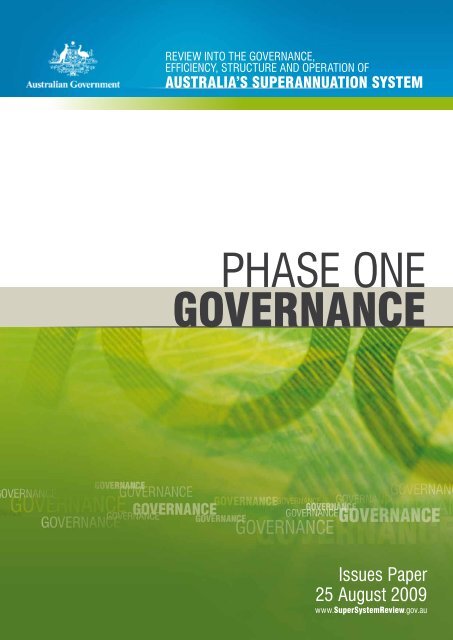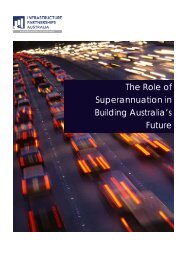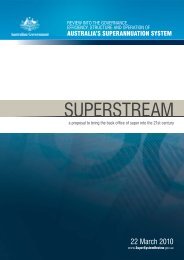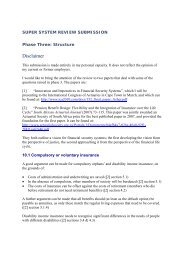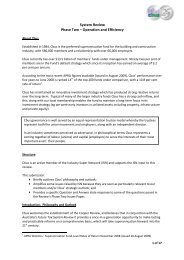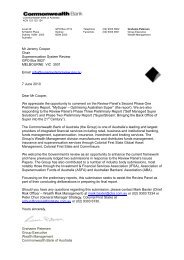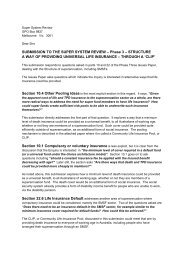Phase One: Governance - Issues Paper - Super System Review
Phase One: Governance - Issues Paper - Super System Review
Phase One: Governance - Issues Paper - Super System Review
- No tags were found...
You also want an ePaper? Increase the reach of your titles
YUMPU automatically turns print PDFs into web optimized ePapers that Google loves.
<strong>Phase</strong> <strong>One</strong>: <strong>Governance</strong> - <strong>Issues</strong> <strong>Paper</strong><strong>Phase</strong> <strong>One</strong>: <strong>Governance</strong><strong>Phase</strong> <strong>One</strong>:<strong>Governance</strong><strong>Phase</strong> Two:OperationandEfficiency<strong>Super</strong><strong>System</strong><strong>Review</strong><strong>Phase</strong>Three:Structure(incl SMSFs)Page | 1
<strong>Phase</strong> <strong>One</strong>: <strong>Governance</strong> - <strong>Issues</strong> <strong>Paper</strong>1 INTRODUCTIONOn 29 May 2009, the Government announced a comprehensive review of Australia'ssuperannuation system: the <strong>Super</strong> <strong>System</strong> <strong>Review</strong> (<strong>Review</strong>).The <strong>Review</strong> has broad terms of reference. 1 It has been charged with examining and analysingthe governance, efficiency, structure and operation of Australia's superannuation system. The<strong>Review</strong> is focused on achieving an outcome that is in the best interests of members and whichmaximises retirement incomes for Australians.The Chair of the <strong>Review</strong> is Jeremy Cooper, a former Deputy Chairman of the Australian Securitiesand Investments Commission (ASIC). Jeremy is supported by a Panel of seven part-timemembers: Mr Kevin Casey, Mr Greg Evans, Mr Sandy Grant, Dr David Gruen, Ms Meg Heffron,Mr Ian Martin and Mr Brian Wilson. Short biographies for each of the Panellists are on the<strong>Review</strong> website. 22 SCOPE OF THE REVIEWThe Scoping <strong>Paper</strong> entitled 'The Scope of the <strong>Review</strong> – a three phased consultation', released on25 August 2009 and available at www.supersystemreview.gov.au, explains the scope of the<strong>Review</strong>.3 THREE-PHASED CONSULTATION PROCESSThe <strong>Review</strong> will be divided into three phases of consultation under the following themes:<strong>Phase</strong> <strong>One</strong> – <strong>Governance</strong><strong>Phase</strong> Two – Operation and Efficiency<strong>Phase</strong> Three – Structure (including SMSFs)This <strong>Issues</strong> <strong>Paper</strong> deals with the first phase: <strong>Governance</strong>.Key dates for <strong>Phase</strong> <strong>One</strong>: <strong>Governance</strong><strong>Phase</strong> <strong>One</strong>: <strong>Governance</strong>Release of <strong>Issues</strong> <strong>Paper</strong>25 August 2009Closing date forsubmissions16 October 2009Release of preliminaryrecommendationsEarly December 2009Submissions for this phase of the <strong>Review</strong> close on 16 October 2009. Section 7 explains how tomake a submission.1 http://www.supersystemreview.gov.au/content/terms_of_reference.aspx2 http://www.supersystemreview.gov.au/content/the_review_panel.aspxPage | 3
<strong>Phase</strong> <strong>One</strong>: <strong>Governance</strong> - <strong>Issues</strong> <strong>Paper</strong>4 BACKGROUND4.1 Introduction<strong>Governance</strong> broadly refers to the ideas, laws, processes and systems by which organisations areoperated, regulated and controlled for the benefit of their relevant stakeholders. <strong>Governance</strong> isparticularly important in the superannuation sector because people typically rely on trustees ofsuperannuation funds to manage their retirement savings, and also frequently rely on the adviceof other key agents to make choices about their superannuation options.Good governance assists in ensuring that the interests of the various stakeholders in the systemare aligned as closely as possible, such that funds are managed in the best interests of members,minimising conflicts of duties and interests and loss to the fund through carelessness or fraud.<strong>Super</strong>annuation funds operate under a trustee model derived from the general law of equity.That is, a corporate trustee, or a group of individual trustees, controls the fund’s assets andoperates them solely for the benefit of its members and beneficiaries. Each trustee has afiduciary obligation to the members and beneficiaries, which involves taking ultimateresponsibility for the entity, and an obligation to manage the assets of the entity withcompetence, diligence, prudence and honesty.The <strong>Super</strong>annuation Industry (<strong>Super</strong>vision) Act 1993 (SIS Act) also specifies obligations oftrustees that automatically form part of the governing rules of all superannuation funds. Manyof the obligations in the SIS Act embody duties already imposed on trustees by trust law. Thisdoes not include the fundamental duties of trustees to avoid or disclose actual or potentialconflicts of interest, although the Corporations Act 2001 conflicts regime 3 will apply if the trustentity has an ASIC-issued Australian financial services licence.To ensure a consistently high standard of governance across the superannuation industry, it isimportant for trustees’ duties to be clearly understood, set at an appropriately high level andexpressed in a way that is sufficiently flexible and robust to continue to accommodatedevelopments in the size, structure and practices of the superannuation industry.4.2 Prudential regulationClosely tied to governance is prudential regulation. Prudential regulation helps ensure thatfunds deliver on their long-term financial promises. Important features of the superannuationfund prudential framework include:the ‘sole purpose test’, designed to ensure superannuation funds are maintained solelyfor retirement income purposes (and a limited range of ancillary purposes, including theprovision of death and disability insurance);licensing of participants through the registrable superannuation entities concept;enforcement powers for the Australian Prudential Regulation Authority (APRA),including powers to investigate trustees and funds, issue directions and disqualifytrustees; and3 Section 912A(1)(aa) and RG 181: Licensing: Managing conflicts of interest (seehttp://www.asic.gov.au/asic/ASIC.NSF/byHeadline/Regulatory%20guides#181)Page | 4
<strong>Phase</strong> <strong>One</strong>: <strong>Governance</strong> - <strong>Issues</strong> <strong>Paper</strong>compensation provisions allowing trustees of APRA-regulated funds to apply for a grantof financial assistance where the fund has suffered loss as a result of fraudulent conductor theft.APRA is responsible for the prudential regulation of all regulated superannuation funds otherthan SMSFs, which the ATO supervises. APRA licenses superannuation trustees and can imposepenalties on trustees that breach their responsibilities under the SIS Act. APRA requires thattrustees operating APRA-regulated superannuation funds, among other things, demonstrate thatthey meet minimum standards of fitness and propriety and have in place appropriate riskmanagement mechanisms to identify, measure and manage risks to the trustee and to the fund.However, unlike with authorised deposit-taking institutions and life offices, APRA does not havea prudential standard-making power in relation to superannuation funds. Rather,superannuation funds are subject to operating standards of the SIS Act and the <strong>Super</strong>annuationIndustry (<strong>Super</strong>vision) Regulations 1994.4.3 Investment strategyAn important aspect of the prudential framework relates to the investment of superannuationassets. Rather than the Government mandating or proscribing certain investments, trusteeshave a duty to formulate and give effect to an investment strategy that gives consideration to,among other things, appropriate diversification, expected cash-flow requirements, the liquidityof the investments and the need to balance risk and return in the best interests of members.However, members can direct a trustee to follow an individual investment strategy where a fundoffers an investment option designed to allow members to invest in accordance with thatstrategy (eg international shares).The SIS Act prohibits or limits certain investment practices that would expose superannuationfunds to excessive risk. This includes a prohibition against borrowing, subject to limitedexceptions allowing trustees to borrow up to prescribed limits to address short-term liquidityissues and to borrow on a limited-recourse basis for the purpose of investing. However,superannuation funds are not prohibited from investing in derivatives that do not involve aborrowing, but can result in losses beyond the initial capital outlay of the investment.5 ISSUES – APRA-REGULATED FUNDSThese issues are not intended to be exhaustive and do not limit submissions to the issues raised.The <strong>Review</strong> may or may not make recommendations on all of them.5.1 General5.1.1 Global financial crisis: Did the global financial crisis highlight any governance problemsin our superannuation system (for example, in risk or liquidity management) and, if so,what were they?5.1.2 Complexity: Is it the case that the complexity of the superannuation system creates itsown governance problems? If so, what are some examples? Are there any governancerequirements that are no longer necessary or impose costs that outweigh intendedbenefits?Page | 5
<strong>Phase</strong> <strong>One</strong>: <strong>Governance</strong> - <strong>Issues</strong> <strong>Paper</strong>5.1.3 Trust model for super: <strong>Super</strong>annuation funds operate under a trustee 4 model derivedfrom the general law of equity. Given the nature of today's public offer, and other large,super funds, is this model still appropriate? Does it still deliver the best outcomes formembers?5.1.4 UN Principles for Responsible Investment (UNPRI): 5 How should APRA-regulated superfunds approach the question of becoming a signatory to the UNPRI or a similar set ofprinciples? Should adopting such principles be mandatory? If this is not the rightapproach, then what would be preferable?5.1.5 Public sector: Are there governance issues specific to public sector funds? If so, whatare they?5.1.6 Best practice: What is the best way to drive best practice governance across theindustry, for example, in the areas of transparency, disclosure, conflicts management,environmental, social and corporate governance and shareholder participation?5.2 Trustees5.2.1 Trustee duties: Would the full or partial codification of duties to act in good faith, avoidand/or disclose real or apparent conflict of interest and not seek personal profit have asignificant impact on trustee governance and the priorities given to various aspects oftheir operations? Would explicit provisions setting the priority of shareholder andmember interests and enabling trustees to override deeds that require the trustee toinvest or outsource within the corporate group help reduce trustee conflicts of interest?Should any additional duties apply to superannuation fund trustees?5.2.2 Trustee knowledge, skills and training: Are trustees adequately equipped to do theirjobs? Is too much expected of trustees?5.2.3 Trustee performance: How is trustee performance measured? How should it bemeasured? Can and do trustees adequately measure their own performance? Are thereadequate benchmarks? What are, or should be, the consequences for underperformance?5.2.4 Apprehension of personal liability: Is trustee behaviour adversely affected by theirapprehension of personal liability, thereby making fund governance more problematic,or is there an adequate balance between the duties of trustees and their potentialliability in the case of a contravention?5.2.5 Trustee independence: Should trustees be members of a fund of which they are atrustee so their interests are more fully aligned, or should they not have a personalinterest in the fund?4 A trustee, in this paper, includes a person who is a trustee in a group of trustees of a fund and a person who is a director of acorporate trustee of a fund.5 See http://www.unpri.org/Page | 6
<strong>Phase</strong> <strong>One</strong>: <strong>Governance</strong> - <strong>Issues</strong> <strong>Paper</strong>5.2.6 Reliance on outsourcing: In many cases, trustees engage third party experts to performa large number of the functions of the fund. Have funds struck the right balancebetween internal and external expertise?5.2.7 Conflicts in outsourcing: In outsourcing so many functions, how do trustees who areassociated with a service provider manage the conflict that arises between the interestsof members and their own or associated interests? What should the rules be where atrustee has a relationship (by way of employment, directorship or ownership) with afund service provider?5.2.8 Composition of the boards and succession planning: Around three-quarters of alltrustees are male and over 50 years old. 6 Some trustee directors stay in office a longtime and others are trustees of more than one fund. What rules should there be aroundqualifications, length of time in office, multiple trusteeships and selection processes fortrustees?5.2.9 Stock lending: Should it be left to trustees to decide if it is in the interests of super fundmembers to have equity investments owned by the fund made available for thepurposes of short-selling or hedging by third parties, or should this practice be regulatedin some way?5.2.10 Consolidation: Should trustees of small funds be obliged to take steps to merge thefund in the pursuit of economies of scale in the long-term interests of members?5.3 Government and regulatory5.3.1 Government policies: Because super is concessionally taxed, compulsory and otherwisefacilitated by Government, should Government:5.3.1.1 use the system to advance other policy objectives such as sustainability,corporate social responsibility and managing climate change;5.3.1.2 be able to influence whether super funds make particular investments (eginfrastructure) either by directly mandating some level of participation (eglike a '20/30 rule') or providing strong incentives to do so; and5.3.1.3 remove barriers (if any) preventing trustees investing in long-terminvestments, such as infrastructure? To what extent do these barriers exist?Are portability and the ability of members to switch between investmentoptions inhibiting the ability of funds to make long-term investments?Should the Government have a role in reducing these barriers and, if so,how?6 APRA INSIGHT ISSUE ONE 2008, <strong>Super</strong>annuation fund governance: Trustee policies and practices.http://www.apra.gov.au/Insight/APRA-Insight-Issue-1-2008.cfmPage | 7
<strong>Phase</strong> <strong>One</strong>: <strong>Governance</strong> - <strong>Issues</strong> <strong>Paper</strong>5.3.2 APRA regulation: Should:5.3.2.1 APRA have a prudential standard-making power or a power to give directionsin relation to superannuation? If so, in relation to what prudential issues?5.3.2.2 APRA’s powers extend beyond prudential matters? If so, in relation to whataspects of superannuation?5.3.3 Sanctions and enforcement: Is the existing sanctions and enforcement frameworkapplying to trustees' regulatory obligations appropriate? Should civil or criminalpenalties (or both, depending on the severity) apply for breaches of the SIS Actcovenants?5.3.4 Related party transactions: A regulated superannuation fund is not subject to theregime governing related party transactions that applies to companies and managedinvestment schemes under the Corporations Act 2001. Is this a gap leading to practicesthat would not be permitted without member approval if the funds were subject to thatregime?5.3.5 2007 PJC Inquiry: In August 2007, the Parliamentary Joint Committee on Corporationsand Financial Services issued a report into the structure and operation of the Australiansuperannuation industry. 7 The committee made 31 recommendations. The <strong>Review</strong>proposes to examine the recommendations of the committee that fall within its terms ofreference and seeks feedback on the following recommendations relating to<strong>Governance</strong> issues:Recommendation 43.35 The committee recommends that peak superannuation bodies and APRA continueto work with the Australian Accounting Standards Board with a view to formingappropriate compulsory accounting and disclosure by all funds for promotionaladvertising, sponsorship expenses and executive remuneration.Recommendation 63.65 The committee recommends that trustees of superannuation funds publicly tenderkey service provision agreements.5.4 Accountability to members5.4.1 Accountability to members: Are super funds, individually or as a class, sufficientlyaccountable to members? How successful has the policy committee structure (Part 9 ofthe SIS Act) been? Do super fund members need a body or association that justrepresents them and advocates their issues? Also, members lack an annual generalmeeting equivalent. Should larger funds host, for example, online AGMs?7 Parliamentary Joint Committee on Corporations and Financial Services The structure and operation of the superannuationindustry August 2007 Page | 8
<strong>Phase</strong> <strong>One</strong>: <strong>Governance</strong> - <strong>Issues</strong> <strong>Paper</strong>5.4.2 Corporate governance of underlying investments: There is currently no formalconnection between the views of super fund members and the exercise of votes onequity investments held by the fund. As members of superannuation funds arecollectively substantial owners of capital, should they have a say on who represents theirinterests in corporate board rooms? How could this be achieved?5.4.3 Responsibility for investments: How do superannuation trustees decide what choicesto offer members? How much responsibility should be placed on trustees for individualinvestment strategies when members make investment choices either with or withoutseparate advice? Is it appropriate to allow fund members to direct a trustee to followany investment strategy a member chooses from the trustee’s available investmentoptions?5.5 Operational5.5.1 Investment Time Horizon: It is often said that superannuation funds and investmentmanagers are too focused on short-term performance. Is this criticism valid and, if so,what are the factors driving short-termism and what, if anything, could be done toencourage a longer-term horizon?5.5.2 Tilt towards equities: Australian super funds seem to have had a bias towards equitiesin their portfolios (around 57 per cent before the global financial crisis, compared withan average of 36 per cent in 20 OECD countries 8 where data are available). This meantthat Australians' superannuation savings were more vulnerable to the global marketturmoil, but equally are likely to benefit from a market recovery. Is this tilt towardsequities justified? Should the Government impose restrictions to enforce morediversification to other asset classes or allow trustees to decide?5.5.3 Portfolio rebalancing: How rigorously do super funds adhere to their portfoliorebalancing policies? What are members told about this? Should there be clearer rulesabout how far out of balance familiar types of portfolios (eg balanced, growth) can gobefore some action has to be taken; for example, some prescribed ranges?5.5.4 Leverage: Are the current exceptions to the borrowing prohibition suitable? Shouldsuperannuation funds be permitted to make investments that can result in investmentlosses beyond the initial capital outlay (such as instalment receipts or contracts fordifference) even if they do not involve borrowing?5.5.5 Tax governance: To what extent do trustees take an interest in the taxation of theunderlying portfolio and, for example, the amount of capital gains tax being incurred?Crystallising capital gains in the accumulation phase can be adverse to members'interests, but will be unavoidable in certain circumstances and for certain types of funds.What are members (or their professional advisers) told about the tax governancepolicies of the fund? Is mandating an across the board obligation to have regard only toafter-tax returns (eg in rewarding managers) a solution?8OECD, Australia – Highlights from OECD Pensions at a Glance: Retirement-Income <strong>System</strong>s in OECD Countries 2009.Page | 9
<strong>Phase</strong> <strong>One</strong>: <strong>Governance</strong> - <strong>Issues</strong> <strong>Paper</strong>6 SELF-MANAGED SUPER FUNDSThere are some important governance issues specific to the SMSF sector. We propose dealingwith those issues, and other issues relating to SMSFs, in the Structure phase. However,stakeholders wishing to make submissions about SMSF governance in this phase are welcometo do so. We expect to devote a substantial part of the resources of the <strong>Review</strong> to SMSFs andwould not want any contrary inference drawn merely because we are proposing to do so inphase three, rather than phase one.7 MAKING A SUBMISSIONThere is no set structure for submissions and participants may comment on any matter theyconsider relevant to the topic. This could range from a short letter outlining your views on thetopic to a more substantial document covering a range of issues. Where possible, you shouldprovide data and/or documentation to support your views.We ask that submissions follow these guidelines:Each submission should be accompanied by a cover sheet as set out in the appendix tothis paper (also available on the <strong>Review</strong> website www.supersystemreview.gov.au). Thisis so we have your contact details. You do not need to repeat your contact details in theactual submission.While submissions may be lodged electronically or by post, electronic lodgement ispreferred. For accessibility reasons, please submit responses sent via email in a Word orRTF format. An additional PDF version may also be submitted.If making a paper submission, please send it printed in black ink on A4 paper.If your submission is more than five pages, please include a summary upfront.Make sure you read the information about public posting and privacy below.Public posting and privacyAll submissions will be treated as public documents. They will be published on the <strong>Review</strong>website, including any personal information of the authors, unless you tell us that you want thesubmission to be treated as wholly or partly confidential or the <strong>Review</strong> thinks that thesubmission should be kept confidential.If you do not want your submission to be made public, please ensure you indicate this in therelevant section of the coversheet and on the front page of your submission.Send your submissionPost:<strong>Super</strong> <strong>System</strong> <strong>Review</strong>GPO Box 9827MELBOURNE VIC 3001Email:info@supersystemreview.gov.auFax:People who need to fax a submission should call 03 9280 4476 for instructionsPage | 10
APPENDIXSUPER SYSTEM REVIEW SUBMISSION COVER SHEET(This form will not be published with your submission)Please complete and attach this form to your submission:By email: info@supersystemreview.gov.auBy post: <strong>Super</strong> <strong>System</strong> <strong>Review</strong>GPO Box 9827MELBOURNE VIC 3001NameStreet addressSuburb/cityState&PostcodePrincipal contact(if organisation)PositionEmail addressPhoneFaxMobilePlease indicate if your submission:contains NO confidential materialcontains SOME confidential material (provided separately and clearly marked)contains confidential material and the WHOLE submission is provided ‘IN CONFIDENCE’Please indicate to which phase your submission relates:<strong>Governance</strong>Operation & EfficiencyStructureAll submissions will be treated as public documents. They will be published on the <strong>Review</strong> website, including anypersonal information of the authors, unless you tell us that you want the submission to be treated as confidential orthe <strong>Review</strong> thinks that the submission should be kept confidential.Confidential material should be provided separately and clearly marked ‘IN CONFIDENCE’.Page | 11


